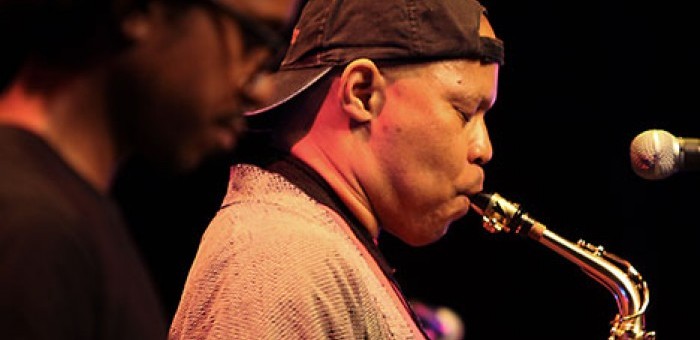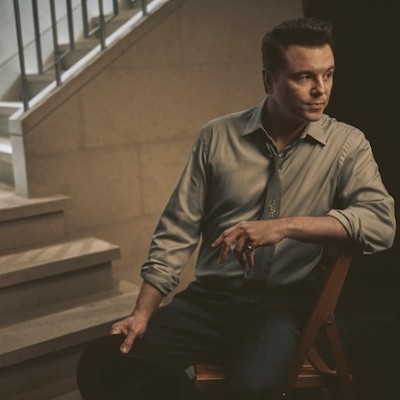Dec 9, 2025 12:28 PM
In Memoriam: Gordon Goodwin, 1954–2025
Gordon Goodwin, an award-winning saxophonist, pianist, bandleader, composer and arranger, died Dec. 8 in Los Angeles.…

Jonathan Finlayson (left) and Steve Coleman at the Atlas Performing Arts Center on Sept. 26 (Photo: Jati Lindsay)
(Photo: )Steve Coleman brought a little bit of the old and a little of the new to Washington, D.C., on Sept. 26 as his ensemble Five Elements kicked off the Atlas Performing Arts Center’s new jazz season. The influential saxophonist, composer and bandleader hadn’t performed in the District in over a decade, so the concert was an auspicious occasion that concluded with a Q&A session moderated by journalist Michael J. West.
The personnel and instrumentation for Coleman’s Five Elements have been in near-constant flux ever since he became the de facto spokesperson for M-BASE in the mid-’80s. The elaborate musical philosophy M-BASE—the acronym stands for “Macro-Basic Array of Structured Extemporizations”—is characterized by intertwining horn improvisations rooted mostly in modern bebop; hyper-intricate, multi-metered, interlocking polyrhythms; and cyclical group interplay that recalls West African drum circles.
Some recent incarnations of Five Elements have included vocalists, Afro-Cuban percussionists, trombonists, various woodwind and brass players and even dancers. At the Atlas concert, though, Coleman fronted a scaled-down version. Bassist Anthony Tidd and drummer Sean Rickman—a splendid rhythmic duo that had performed with Five Elements between the late ’90s and early aughts—was back in the lineup, joining trumpeter Jonathan Finlayson, one of the newer members.
The piano-less quartet didn’t lack firepower. The leaner Five Elements sounded meaner, too, exhibiting an elasticity that was unruffled by peculiarities such as the pipa and spoken-word artists of recent past. Coleman began the proceedings with an extended solo improvisation filled with fluid, zigzagging passages. His tone has softened lately, revealing an unexpected comeliness that wasn’t so apparent a decade ago. Soon, Finlayson entered with an elaborate fugue-like counterpart that showcased his burnished tone. This gave way to Tidd thumping the ominous bass ostinato for “Wheel Of Nature,” an entrancing classic from Coleman’s 1997 double-disc set, Genesis & The Opening Of The Way. Rickman underscored Tidd with a serrated, intricate pattern that evolved with increasing complexity as he accentuated the pulse with unexpected tom-tom fills and quick double-pedal bass-drum accents.
From there, Five Elements ventured deep into a heady, almost nonstop suite. The music became an elaborate jigsaw puzzle, the pieces made of compositions from Coleman’s expansive repertoire. Familiarity came through the feel of the songs more than any discernable melodies. The ensemble made complete stops with sniper-like precision a few times, but Coleman didn’t bother to announce any of the pieces’ titles.
The music’s intrepidness didn’t hinder the listening pleasure, though. Coleman dazzled as an improvising daredevil, prone to building statements out of recurring motifs one moment and then unleashing prolix essays the next. Finlayson was an ideal frontline partner. Like Coleman, the trumpeter can uncoil knotty figures with supple grace. He also showed his knack for blowing hushed textures underneath Coleman’s corkscrew passages.
As for Rickman and Tidd, it’s a toss-up as to which one deserved the MVP award. Rickman’s dexterity, sense of time and ingenuity at steering the momentum while constantly shifting and shaping the rhythmic framework were stupendous. He functioned almost like a pianist in the group.
But it was Tidd’s sometimes deceptively simple bass lines that held all the hyperactivity together. He also underscored much of the diverse cultural evocation in Coleman’s music, with bass accompaniments alluding to Cuba, Senegal, Morocco and New Orleans.
Toward the end of the set, Coleman and Five Elements covered a wealth of musical terrain with material that sounded simultaneously familiar and foreign but certainly not forgettable.
—John Murph

Goodwin was one of the most acclaimed, successful and influential jazz musicians of his generation.
Dec 9, 2025 12:28 PM
Gordon Goodwin, an award-winning saxophonist, pianist, bandleader, composer and arranger, died Dec. 8 in Los Angeles.…

Flea has returned to his first instrument — the trumpet — and assembled a dream band of jazz musicians to record a new album.
Dec 2, 2025 2:01 AM
After a nearly five-decade career as one of his generation’s defining rock bassists, Flea has returned to his first…

“It’s a pleasure and an honor to interpret the music of Oscar Peterson in his native city,” said Jim Doxas in regard to celebrating the Canadian legend. “He traveled the world, but never forgot Montreal.”
Nov 18, 2025 12:16 PM
In the pantheon of jazz luminaries, few shine as brightly, or swing as hard, as Oscar Peterson. A century ago, a…

Dec 11, 2025 11:00 AM
DownBeat presents a complete list of the 4-, 4½- and 5-star albums from 2025 in one convenient package. It’s a great…

Seth MacFarlane takes a turn from his television and film career to sing arrangements made for Frank Sinatra, but never recorded.
Nov 18, 2025 12:04 PM
“I’m not gonna lie to you — I don’t know why I thought this was about The Naked Gun, but I’m happy it’s…